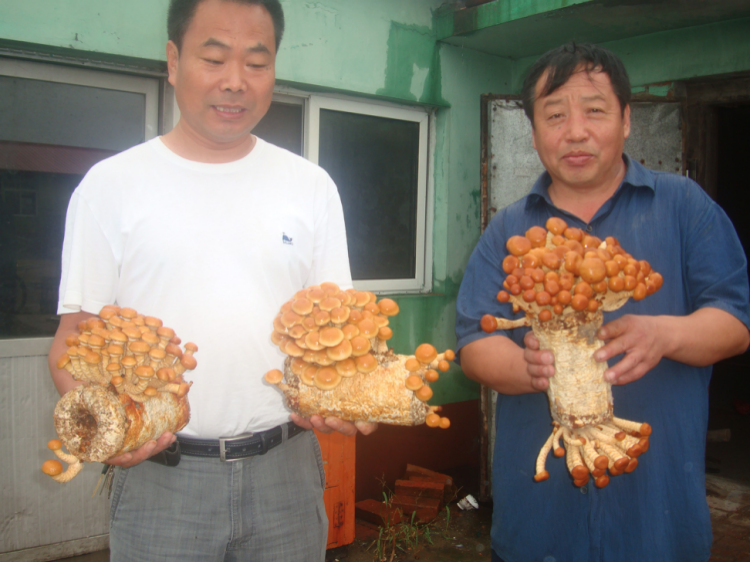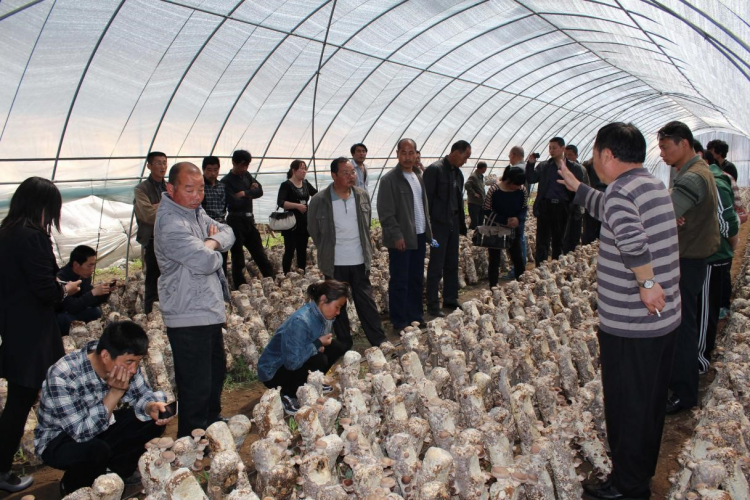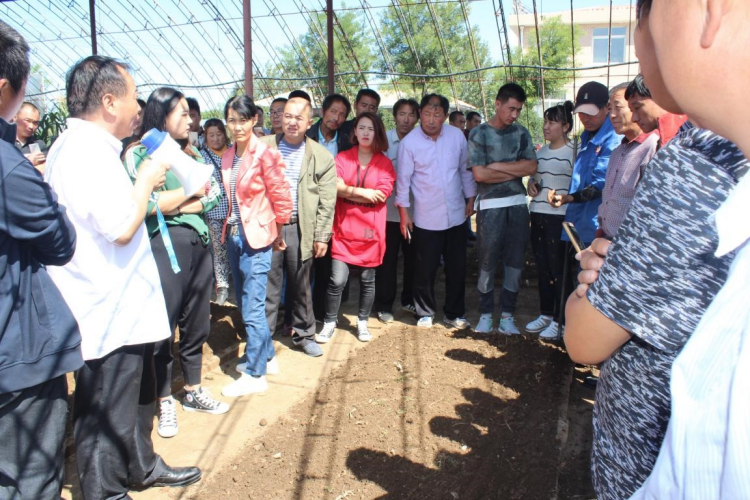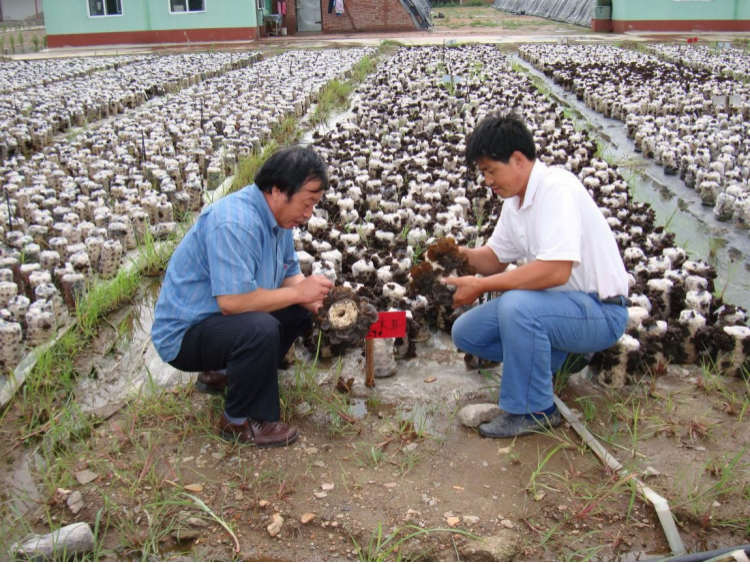Liang Xicai: Thirty years spent running about all over Pingquan in his research of edible fungus
author: | source: | Update time : 2018-08-31
In April 2018, at the China (Sanmenxia City) Edible Fungus New Products and Technologies Expo, he was awarded the title of “Craftsmanship” in the edible fungus industry. The organizing committee praised him as follows: In the past 30 years, he has introduced, tested and demonstrated more than 30 new varieties of edible fungi and more than 40 new technologies, and trained more than 30,000 farmers. For 30 years, he took root at his hometown, bowing his head and pioneering in hardships and poverty. He has finally found a way to get rid of poverty and become rich by developing edible fungi. As founders and advocates of the edible fungus industry in Pingquan City, Hebei Province, Liang Xicai and a group of edible fungus experts represented by him, through painstaking work and persistent scientific and technological innovation, have enabled Pingquan City to achieve multiple breakthroughs in terms of edible fungus study. The Edible Fungus Research Association of Pingquan City and its affiliated Xicai Edible Fungus Science & Technology Development Co., Ltd. have also developed into a leading enterprise integrating scientific research and production.
I hope to dedicate my life to the cause of edible fungus and become the pioneer of the Pingquan edible fungus industry
In December 1958, Liang Xicai was born in Shaoguoyingzi Village, Maolangou Township, Pingquan.Liang Xicai graduated from junior high school in 1974 when was 16 years old. He learned to be carpenter and mason, worked in coal mines, participated in railway construction, planted fruit trees for his brigade and participated in dams construction.
“At that time, there were newspapers in the production brigade. When I had the time, I would read the newspapers. I read reports of scientific experts in the newspapers, accompanied by a photo of an expert wearing white coat looking at the microscope. Enviable!” At that time, Liang Xicai had a dream in his heart. It would be such a great thing if one day he could become someone like that!
At the age of 23, the soil and fertilizer station of the county’s agricultural bureau recruited laboratory technical staff. Being educated and as a technical staff of the production brigade, Liang Xicai realized his dream to wear a white coat and become a laboratory technical staff at the soil and fertilizer station. Liang said: “Now, as soon as I walk into my own edible fungus research laboratory, I have an unspeakable excitement in my heart.” In 1985, Liang Xicai was sent to Baoding Microbiology Institute by the Pingquan Agricultural Bureau to participate in the training course on edible fungi. After returning to the county and, with the support of the competent leaders, he invested 1,000 yuan and succeeded in his experiment of 500 bags of oyster mushroom. Since then, his career in edible fungus blasted off.
By 1989, the development of edible fungi covered 40 administrative villages in 10 townships and towns of the county, with a total output of 100 tons. However, farmers didn’t benefit much from it, plus student unrest, fungi could not be sold, and fell into a trough. In 1990, Liang Xicai, after investigation and analysis, argued that Pingquan’s production of oyster mushroom was at a disadvantage in the market competition with similar products from the Central Plains, and it was difficult to develop on a large scale. He carefully studied the local climate characteristics and advantages and disadvantages, and proposed to develop wood-decay fungi and the selection of low-temperature varieties.
On the seventh day of the twelfth lunar month, he braved the cold to go to Liaoning to inspect, from Tieling to Xiuyan, and then to Zhuanghe. After repeated comparisons, he introduced a variety of nameko suitable for production in Pingquan. At first, the masses did not accept, because they were afraid of taking risks. He used his own house as a mortgage to mobilize the masses in his hometown, and both inside and outside the county. In the same year, 24 households were mobilized and succeeded. In the second year, more than 500 households were moblized, and they all achieved considerable economic benefits. From then on, nameko became the main variety of Pingquan and surrounding areas. Then he took his company’s technical team to work on the breeding of the nameko species. After three years of hard work, a yellow-white “Early Life 2” strain was selected, and the output was increased from the original 3.5 jin to 5 jin. This technology has widened the gap with the place of origin, making Pingquan the No.1 production place of nameko nationwide. In 1994, he was assigned to Qingyuan, Zhejiang, Shouning, Fujian, and Xixia, Henan Province to inspect the wood mushroom production projects.
The development of new varieties, new technologies and new models of edible fungi is the goal of Liang’s lifelong struggle. He found out their characteristics and operating rules based on the experience and understanding of edible and medicinal fungi, and selected the most advantageous varieties and models in Pingquan. In 2000, the model of shiitake mushrooms was introduced, which solved the problem of no mushrooms from July to September. In 2011, cut-free film was used for wood mushrooms, which enabled whole year production.
Life is short while scientific research is endless After 30 years of active exploration and technological innovation, Liang Xicai has introduced, tested, demonstrated and promoted more than 30 new varieties of edible fungus for Pingquan City, among which nameko, wood mushroom, black fungus and morel have become major varieties in northern China. And each variety has an incomparable advantage in each place of origin. Whenever he introduces a new variety, he requires two conditions. One is that whether there is comparative advantage with the place of origin, and the other is that whether the introduced varieties have comparative advantage over local breeds. For many years, he has been dedicated to scientific research, disregarding personal gain or loss, and he has always been at the forefront of domestic and international technological development. He has cooperated with the national edible fungus system, many universities and colleges to solve the problem of “solid/liquid transfer process” with a very simple method. The double-layer plastic air bubble film method can increase the effective output period of the wood mushroom by 60 days, and the use of a convection ventilation method in a single-layer green-white membrane greenhouse unintentionally solved the two major problems of yellow spot disease (oyster mushroom) and white slime (nameko) at room temperature, which was highly praised by experts and farmers by saying that he has achieved the results of a fifth-generation greenhouse while controlling the cost at a second-generation level (Pingquan has already developed the sixth-generation greenhouse). With the support of the national, provincial and municipal edible fungus systems, his team has reduced the production cost of strains and nutrition bags to less than 2,000 yuan/mu through the trial of two morel cultivation cycles. Currently, the patent is being applied for.
Liang Xicai has received numerous awards in the past 30 years. However, this is not all he pursued and this is not what he dedicates his life to the edible fungus industry for. For Liang Xicai, the introduction of new varieties, the persistence in scientific research and the blessing of the masses are the goals that he has always pursued throughout his life.
In December 2007, a new domesticated black fungus variety “Black A” was selected from wild species to be identified as the national edible fungus variety. The variety has high yield and good taste, and is deeply loved by the majority of farmers and consumers, becoming the main variety of black fungus production in Pingquan and surrounding areas;
In October 2010, he used the six transformation processes in the growth of the nameko, and through detoxification, mutagenesis and other technical means, the new variety of the nameko, “Early No.2”, was selected and domesticated to be identified as the national edible fungus variety too. The variety has good quality, high yield, strong adaptability and good economic benefits, and has become the main variety of key production areas in Hebei and Inner Mongolia;
On June 19, 2013, the new variety Hericium Coralloides (Snow Matsutake)—A Method for the Production of Hericium Coralloides —won the national invention patent. The patent number is ZL 2012 1 0149418.X;
On July 31, 2013, A Variety of Hericium Coralloides won the national invention patent. The patent number is: ZL 2012 1 0149416.0;In January 2011, the Inspection and Testing of Edible Fungi Species won the third prize of the Pingquan Science and Technology Progress County Magistrate Award.
In the past 30 years, he has organized more than 1,500 various types of training courses in rural areas. The number of teaching hours has reached more than 6,000 hours; more than 50,000 farmers have been trained; more than 300,000 technical consultations have been received; 50,000 copies of technical materials have been distributed free of charge; 850,000 yuan was invested for free. The training covers 19 townships in the county, such as Kuancheng, Longhua, Weichang and Chengde, and provinces and municipalities such as Jilin, Liaoning, Inner Mongolia and Beijing.
Liang Xicai, a child who grew up in an ordinary family and a child without a higher education, has perseverance, aspiration, ambition and dedication. He once went on a hunger strike for 72 hours just to get loans. His achievement in the edible fungus industry is not the most praiseworthy, nor is it his greatest wealth. It is his spirit and virtues of immortal value that we are proud of, learn from and respect.








